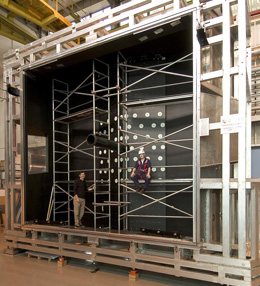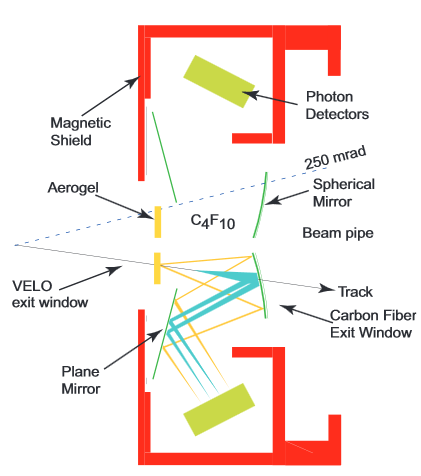The RICH system has the task of identifying charged particles over the momentum range 1-150 GeV/c, within an angular acceptance of 10-300 milliradians (mrad).
Particle identification is crucial to reduce background in selected final states (see graphs below) and to provide an efficient tag of the b-quark flavour using the kaon from the other b-quark produced in an event.

The system consists of an upstream detector (RICH-1) with silica aerogel and C4F10 gas radiators, positioned directly behind the VELO, and a downstream detector (RICH-2) with a CF4 gas radiator, located behind the magnet and the tracking system.
Mirrors and radiators

Silica aerogel is a colloidal form of quartz solid, but with an extremely low density and a high refractive index (1.01–1.10), which makes it perfect for the lowest-momentum particles (order of a few GeV/c). To cover the regions of medium and high momentum, LHCb uses a combination of C4F10 and CF4 radiators for momenta from around 10 GeV/c to around 65 GeV/c, and from around 15 GeV/c to more than 100 GeV/c, respectively.
With its silica aerogel and C4F10 gas radiator the RICH-1 detector is therefore set up to detect low-momentum particles, while RICH-2 has an acceptance that is limited to the low-angle region where there are mostly high-momentum particles and uses a CF4 gas radiator.

Particles produced in the collisions in LHCb will travel through the mirrors of RICH-1 prior to reaching measurement components further downstream. To reduce the amount of scattering, RICH-1 uses special lightweight spherical mirrors constructed from a carbon-fibre reinforced polymer (CFRP), rather than glass. There are four of these mirrors, each made from two CFRP sheets moulded into a spherical surface with a radius of 2700 mm and separated by a reinforcing matrix of CFRP cylinders.
As RICH-2 is located downstream of the tracking system and magnet, glass could be used for its spherical mirrors, which in this case are composed of hexagonal elements.
Seeing the light
Both RICH detectors use hybrid photon detectors (HPDs) to measure the positions of the emitted Cherenkov photons. The HPD is a vacuum photon detector in which a photoelectron, released when an incident photon converts within a photocathode, is accelerated by a high voltage of typically 10–20 kV onto a reverse-biased silicon detector. The tube focuses the photoelectron electrostatically – with a demagnification factor of around five – onto a small silicon detector array.

The LHCb collaboration has developed a novel dedicated pixel–HPD for the RICH detectors, working in close co-operation with industry. Here, the silicon detector is segmented into 1024 “super” pixels, each 500 μm × 500 μm in area and arranged as a matrix of 32 rows and 32 columns.
When a photoelectron loses energy in silicon, it creates electron-hole pairs at an average yield of one for every 3.6 eV of deposited energy. The nominal operating voltage of LHCb’s HPDs is –20 kV, corresponding to around 5000 electron-hole pairs released in the silicon. Careful design of read-out electronics and interconnects to the silicon detector results in a high efficiency for detecting single photoelectrons. The experiment requires 484 tubes in total – 196 for RICH-1 and 288 for RICH-2 – to cover the four detection surfaces.
